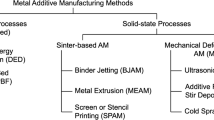Abstract
Inconel alloy 617 was used in the present research because of its high strength and oxidation resistance in a wide range of temperatures. In this investigation, full-penetration welding of 1.5-mm-thin Inconel 617 plates in a butt configuration was carried out with a fibre laser welding machine of 400 W. The influence of different welding conditions, such as welding speed, welding power on the heat-affected zone morphology, metallurgy and mechanical properties has been discussed in detail in this study. Microstructures have been assessed by optical microscope and by field emission scanning electron microscope. On the other hand, mechanical behaviour has been analysed in terms of Vickers microhardness and compared with specimens of base materials under different welding conditions. Tensile test has been conducted on standard welded specimen and its tensile strength along with percentage elongation has been analysed and compared with base metal specimen. Surface topography at the fractured region of the specimen has also been studied. EDAX analysis has been done at different regions of the welded samples to study the chemical composition at various regions of the welded samples. During the investigation, XRD analysis was carried out at different positions (2θ°) to analyse the crystallographic structure and to get the maximum intensity of the compound matrix at different positions. During the microhardness test, hardness of the base metal was found to be lower in comparison with the fusion zone due to rapid cooling.














Similar content being viewed by others
References
Henderson M, Arrell D, Larsson R, Heobel M, Marchant G (2004) Nickel based superalloy welding practices for industrial gas turbine applications. Sci Technol Weld Join 9:13–21
Lippold JC, Kiser SD, DuPont JN (2011) Welding metallurgy and weldability of nickel-base alloys. Wiley, New Jersey
Moosavy HN, Aboutalebi MR, Seyedein SH, Goodarzi M, Khodabakhshi M, Mapelli C, Barella S (2014) Modern fibre laser beam welding of the newly-designed precipitation-strengthened nickel-base superalloys. Opt Laser Technol 57:12–20
Mankins WL, Hosier JC, Bassford TH (1974) Microstructure and phase stability of Inconel alloy 617. Metall Trans 5(12):2579–2590
Cabibbo M, Gariboldi E, Spigarelli S, Ripamonti D (2008) Creep behavior of INCOLOY alloy 617. J Mater Sci 43:2912–2921
Shah Hosseini H, Shamanian M, Kermanpur A (2011) Characterization of microstructures and mechanical properties of Inconel 617/310 stainless steel dissimilar welds. J Mater Charact 62(4):425–431
Quintino L, Costa A, Miranda R, Yapp D (2007) Welding with high power fibre lasers—a preliminary study. Mater Des Issue 4:1231–1237
Totemeier TC, Lian H, Clark DE, Simpson JA (2005) Microstructure and strength characteristics of alloy 617 welds. INL/EXT-05-00488
Ai Yuewei, Jiang Ping, Shao Xinyu, Wang Chunming, Li Peigen, GaoyangMi Yang Liu, Liu Wei (2016) A defect-responsive optimization method for the fibre laser butt welding of dissimilar materials. J Mater Des 90:669–681
Ebrahimi AN, Arab NBM, Gollo MH (2016) Thermal analysis of laser beam welding of nickel-based super alloy Inconel 625 to AISI 316L, using Gaussian optics theory in keyhole. J Braz Soc Mech Sci Eng 38:1199–1206. doi:10.1007/s40430-015-0422-5
Naffakh H, Shamanian M, Ashrafizadeh F (2009) Dissimilar welding of AISI 310 austenitic stainless steel to nickel-based alloy Inconel 657. J Mater Process Technol 209:3628–3639
El-Awadi GA, Abdel-Samad S, Elshazly ES (2016) Hot corrosion behavior of Ni based Inconel 617 and Inconel 738 superalloys. J Appl Surf Sci 378:224–230
Elmer JW, Vaja J, Carlton HD, Pong R (2015) The effect of Ar and N2 shielding gas on laser weld porosity in steel, stainless steels, and nickel. Suppl Weld J 94(10):313s–325s
Totemeier TC, Tian H, Clark DE, Simpson JA (2005) Microstructure and strength characteristics of alloy 617 welds. INL/EXT-05-00488
Ren W, Lu F, Yang R, Liu X, Li Z, Hosseini SRE (2015) A comparative study on fibre laser and CO 2 laser welding of Inconel 617. Mater Des 76:207–214
Liu Wen, Fenggui Lu, Yang Renjie, Tang Xinhua, Cui Haichao (2015) Gleeble simulation of the HAZ in Inconel 617 welding. J Mater Process Technol 225:221–228
Author information
Authors and Affiliations
Corresponding author
Additional information
Technical Editor: Márcio Bacci da Silva.
Rights and permissions
About this article
Cite this article
Kumar, P., Saw, K., Kumar, U. et al. Effect of laser power and welding speed on microstructure and mechanical properties of fibre laser-welded Inconel 617 thin sheet. J Braz. Soc. Mech. Sci. Eng. 39, 4579–4588 (2017). https://doi.org/10.1007/s40430-017-0734-8
Received:
Accepted:
Published:
Issue Date:
DOI: https://doi.org/10.1007/s40430-017-0734-8




